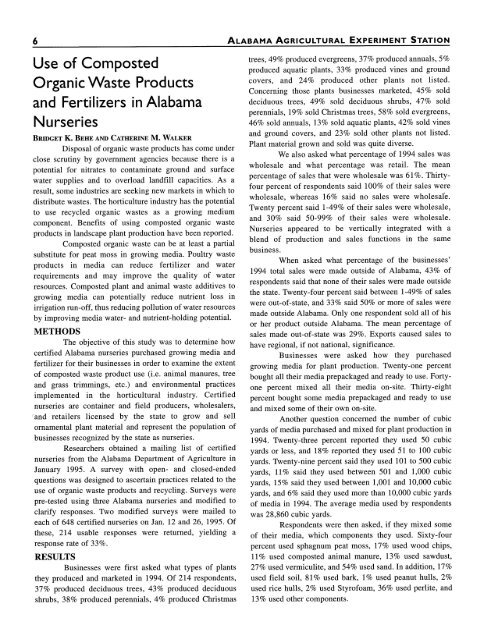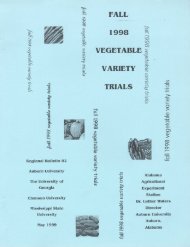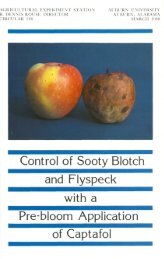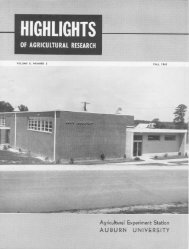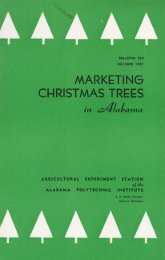1997 Ornamentals Research Report - AUrora - Auburn University
1997 Ornamentals Research Report - AUrora - Auburn University
1997 Ornamentals Research Report - AUrora - Auburn University
You also want an ePaper? Increase the reach of your titles
YUMPU automatically turns print PDFs into web optimized ePapers that Google loves.
6 ALABAMA AGRICULTURAL EXPERIMENT STATION<br />
Use of Composted<br />
Organic Waste Products<br />
and Fertilizers in Alabama<br />
Nurseries<br />
BRIDGET K. BEIE AND CATHERINE M. WALKER<br />
Disposal of organic waste products has come under<br />
close scrutiny by government agencies because there is a<br />
potential for nitrates to contaminate ground and surface<br />
water supplies and to overload landfill capacities. As a<br />
result, some industries are seeking new markets in which to<br />
distribute wastes. The horticulture industry has the potential<br />
to use recycled organic wastes as a growing medium<br />
component. Benefits of using composted organic waste<br />
products in landscape plant production have been reported.<br />
Composted organic waste can be at least a partial<br />
substitute for peat moss in growing media. Poultry waste<br />
products in media can reduce fertilizer and water<br />
requirements and may improve the quality of water<br />
resources. Composted plant and animal waste additives to<br />
growing media can potentially reduce nutrient loss in<br />
irrigation run-off, thus reducing pollution of water resources<br />
by improving media water- and nutrient-holding potential.<br />
METHODS<br />
The objective of this study was to determine how<br />
certified Alabama nurseries purchased growing media and<br />
fertilizer for their businesses in order to examine the extent<br />
of composted waste product use (i.e. animal manures, tree<br />
and grass trimmings, etc.) and environmental practices<br />
implemented in the horticultural industry. Certified<br />
nurseries are container and field producers, wholesalers,<br />
,and retailers licensed by the state to grow and sell<br />
ornamental plant material and represent the population of<br />
businesses recognized by the state as nurseries.<br />
<strong>Research</strong>ers obtained a mailing list of certified<br />
nurseries from the Alabama Department of Agriculture in<br />
January 1995. A survey with open- and closed-ended<br />
questions was designed to ascertain practices related to the<br />
use of organic waste products and recycling. Surveys were<br />
pre-tested using three Alabama nurseries and modified to<br />
clarify responses. Two modified surveys were mailed to<br />
each of 648 certified nurseries on Jan. 12 and 26, 1995. Of<br />
these, 214 usable responses were returned, yielding a<br />
response rate of 33 %.<br />
RESULTS<br />
Businesses were first asked what types of plants<br />
they produced and marketed in 1994. Of 214 respondents,<br />
37% produced deciduous trees, 43% produced deciduous<br />
shrubs, 38% produced perennials, 4% produced Christmas 13% ued oher ompoents<br />
trees, 49% produced evergreens, 37% produced annuals, 5%<br />
produced aquatic plants, 33% produced vines and ground<br />
covers, and 24% produced other plants not listed.<br />
Concerning those plants businesses marketed, 45% sold<br />
deciduous trees, 49% sold deciduous shrubs, 47% sold<br />
perennials, 19% sold Christmas trees, 58% sold evergreens,<br />
46% sold annuals, 13% sold aquatic plants, 42% sold vines<br />
and ground covers, and 23% sold other plants not listed.<br />
Plant material grown and sold was quite diverse.<br />
We also asked what percentage of 1994 sales was<br />
wholesale and what percentage was retail. The mean<br />
percentage of sales that were wholesale was 61%. Thirtyfour<br />
percent of respondents said 100% of their sales were<br />
wholesale, whereas 16% said no sales were wholesale.<br />
Twenty percent said 1-49% of their sales were wholesale,<br />
and 30% said 50-99% of their sales were wholesale.<br />
Nurseries appeared to be vertically integrated with a<br />
blend of production and sales functions in the same<br />
business.<br />
When asked what percentage of the businesses'<br />
1994 total sales were made outside of Alabama, 43% of<br />
respondents said that none of their sales were made outside<br />
the state. Twenty-four percent said between 1-49% of sales<br />
were out-of-state, and 33% said 50% or more of sales were<br />
made outside Alabama. Only one respondent sold all of his<br />
or her product outside Alabama. The mean percentage of<br />
sales made out-of-state was 29%. Exports caused sales to<br />
have regional, if not national, significance.<br />
Businesses were asked how they purchased<br />
growing media for plant production. Twenty-one percent<br />
bought all their media prepackaged and ready to use. Fortyone<br />
percent mixed all their media on-site. Thirty-eight<br />
percent bought some media prepackaged and ready to use<br />
and mixed some of their own on-site.<br />
Another question concerned the number of cubic<br />
yards of media purchased and mixed for plant production in<br />
1994. Twenty-three percent reported they used 50 cubic<br />
yards or less, and 18% reported they used 51 to 100 cubic<br />
yards. Twenty-nine percent said they used 101 to 500 cubic<br />
yards, 11% said they used between 501 and 1,000 cubic<br />
yards, 15% said they used between 1,001 and 10,000 cubic<br />
yards, and 6% said they used more than 10,000 cubic yards<br />
of media in 1994. The average media used by respondents<br />
was 28,860 cubic yards.<br />
Respondents were then asked, if they mixed some<br />
of their media, which components they used. Sixty-four<br />
percent used sphagnum peat moss, 17% used wood chips,<br />
11% used composted animal manure, 13% used sawdust,<br />
27% used vermiculite, and 54% used sand. In addition, 17%<br />
used field soil, 81% used bark, 1% used peanut hulls, 2%<br />
used rice hulls, 2% used Styrofoam, 36% used perlite, and


